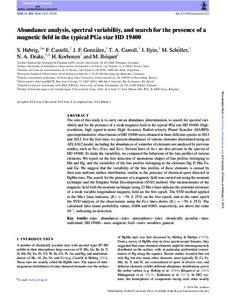Abundance analysis, spectral variability, and search for the presence of a magnetic field in the typical PGa star HD 19400
Hubrig S.; Castelli F.; González J.F.; Carroll T.A.; Ilyin I.; Schöller M.; Drake N.A.; Korhonen H.; Briquet; M.
https://urn.fi/URN:NBN:fi-fe2021042714447
Tiivistelmä
The aim of this study is to carry out an abundance determination, to search for spectral variability and for the presence of a weak magnetic field in the typical PGa star HD 19400. High-resolution, high signal-to-noise High Accuracy Radial-velocity Planet Searcher (HARPS) spectropolarimetric observations of HD 19400 were obtained at three different epochs in 2011 and 2013. For the first time, we present abundances of various elements determined using an ATLAS12 model, including the abundances of a number of elements not analysed by previous studies, such as Ne I, Ga II, and Xe II. Several lines of As II are also present in the spectra of HD 19400. To study the variability, we compared the behaviour of the line profiles of various elements. We report on the first detection of anomalous shapes of line profiles belonging to Mn and Hg, and the variability of the line profiles belonging to the elements Hg, P, Mn, Fe, and Ga. We suggest that the variability of the line profiles of these elements is caused by their non-uniform surface distribution, similar to the presence of chemical spots detected in HgMn stars. The search for the presence of a magnetic field was carried out using the moment technique and the Singular Value Decomposition (SVD) method. Our measurements of the magnetic field with the moment technique using 22 Mn II lines indicate the potential existence of a weak variable longitudinal magnetic field on the first epoch. The SVD method applied to the Mn II lines indicates <Bz> = -76 ± 25 G on the first epoch, and at the same epoch the SVD analysis of the observations using the Fe II lines shows <Bz> = -91 ± 35 G. The calculated false alarm probability values, 0.008 and 0.003, respectively, are above the value 10-3, indicating no detection.
Kokoelmat
- Rinnakkaistallenteet [27094]
